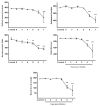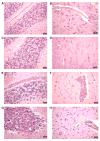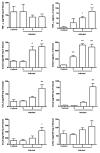Inflammatory changes in the central nervous system are associated with behavioral impairment in Plasmodium berghei (strain ANKA)-infected mice
- PMID: 20138873
- PMCID: PMC3111979
- DOI: 10.1016/j.exppara.2010.02.002
Inflammatory changes in the central nervous system are associated with behavioral impairment in Plasmodium berghei (strain ANKA)-infected mice
Abstract
Experimental cerebral malaria is a neuroinflammatory condition that results from the host immune response to the parasite. Using intravital microscopy, we investigated leukocyte recruitment in the brain microcirculation and the temporal relationship of this process to the behavioral changes observed in Plasmodium berghei (strain ANKA)-infected C57Bl/6 mice. We found that leukocyte recruitment was increased from day 5 post-infection (p.i.) onwards. Histopathological changes and increased levels of inflammatory cytokines in the brain were also observed. Behavioral performance evaluated by the SHIRPA protocol showed functional impairment from day 6 p.i. onwards. Thus, early leukocyte migration into the brain and associated inflammatory changes may be involved in neurological impairment in parasite-infected C57Bl/6 mice.
Figures






Similar articles
-
Disruption of Parasite hmgb2 Gene Attenuates Plasmodium berghei ANKA Pathogenicity.Infect Immun. 2015 Jul;83(7):2771-84. doi: 10.1128/IAI.03129-14. Epub 2015 Apr 27. Infect Immun. 2015. PMID: 25916985 Free PMC article.
-
Anxiety-like behavior and proinflammatory cytokine levels in the brain of C57BL/6 mice infected with Plasmodium berghei (strain ANKA).Neurosci Lett. 2011 Mar 24;491(3):202-6. doi: 10.1016/j.neulet.2011.01.038. Epub 2011 Jan 21. Neurosci Lett. 2011. PMID: 21256928
-
Endothelin-1 Treatment Induces an Experimental Cerebral Malaria-Like Syndrome in C57BL/6 Mice Infected with Plasmodium berghei NK65.Am J Pathol. 2016 Nov;186(11):2957-2969. doi: 10.1016/j.ajpath.2016.07.020. Epub 2016 Sep 15. Am J Pathol. 2016. PMID: 27640146 Free PMC article.
-
Intercellular adhesion molecule 1 is important for the development of severe experimental malaria but is not required for leukocyte adhesion in the brain.J Investig Med. 2003 May;51(3):128-40. doi: 10.1136/jim-51-03-15. J Investig Med. 2003. PMID: 12769195
-
Genetic analysis of cerebral malaria in the mouse model infected with Plasmodium berghei.Mamm Genome. 2018 Aug;29(7-8):488-506. doi: 10.1007/s00335-018-9752-9. Epub 2018 Jun 19. Mamm Genome. 2018. PMID: 29922917 Review.
Cited by
-
Experimental Models of Microvascular Immunopathology: The Example of Cerebral Malaria.J Neuroinfect Dis. 2014 Feb;5(1):134. Epub 2014 Jan 6. J Neuroinfect Dis. 2014. PMID: 26430675 Free PMC article.
-
Neuroimmunological blood brain barrier opening in experimental cerebral malaria.PLoS Pathog. 2012;8(10):e1002982. doi: 10.1371/journal.ppat.1002982. Epub 2012 Oct 25. PLoS Pathog. 2012. PMID: 23133375 Free PMC article.
-
Interleukin-18 Antagonism Improved Histopathological Conditions of Malaria Infection in Mice.Iran J Parasitol. 2015 Jul-Sep;10(3):389-401. Iran J Parasitol. 2015. PMID: 26622294 Free PMC article.
-
Behavioural and neurological symptoms accompanied by cellular neuroinflammation in IL-10-deficient mice infected with Plasmodium chabaudi.Malar J. 2016 Aug 24;15(1):428. doi: 10.1186/s12936-016-1477-1. Malar J. 2016. PMID: 27557867 Free PMC article.
-
Effect of mushroom Agaricus blazei on immune response and development of experimental cerebral malaria.Malar J. 2015 Aug 11;14:311. doi: 10.1186/s12936-015-0832-y. Malar J. 2015. PMID: 26260055 Free PMC article.
References
-
- Bagot S, Idrissa Boubou M, Campino S, Behrschmidt C, Gorgette O, Guenet JL, Penha-Goncalves C, Mazier D, Pied S, Cazenave PA. Susceptibility to experimental cerebral malaria induced by Plasmodium berghei ANKA in inbred mouse strains recently derived from wild stock. Infection and Immunity. 2002;70:2049–2056. - PMC - PubMed
-
- Barcelos LS, Talvani A, Teixeira AS, Vieira LQ, Cassali GD, Andrade SP, Teixeira MM. Impaired inflammatory angiogenesis, but not leukocyte influx, in mice lacking TNFR1. Journal of Leukocyte Biology. 2005;78:352–358. - PubMed
-
- Belnoue E, Kayibanda M, Vigario AM, Deschemin JC, van Rooijen N, Viguier M, Snounou G, Rénia L. On the pathogenic role of brain-sequestered alphabeta CD8+ T cells in experimental cerebral malaria. Journal of Immunology. 2002;169:6369–6375. - PubMed
-
- Campanella GS, Tager AM, El Khoury JK, Thomas SY, Abrazinski TA, Manice LA, Colvin RA, Luster AD. Chemokine receptor CXCR3 and its ligands CXCL9 and CXCL10 are required for the development of murine cerebral malaria. Proceedings of the National Academy of Sciences of the United States of America. 2008;105:4814–4819. - PMC - PubMed
-
- Cutrullis RA, Postan M, Petray PB, Corral RS. Timing of expression of inflammatory mediators in skeletal muscles from mice acutely infected with the RA strain of Trypanosoma cruzi. Pathobiology. 2009;76:170–180. - PubMed
Publication types
MeSH terms
Substances
Grants and funding
LinkOut - more resources
Full Text Sources

